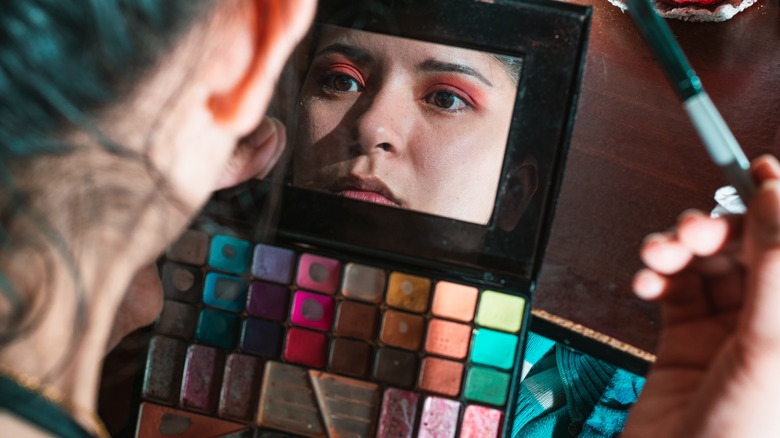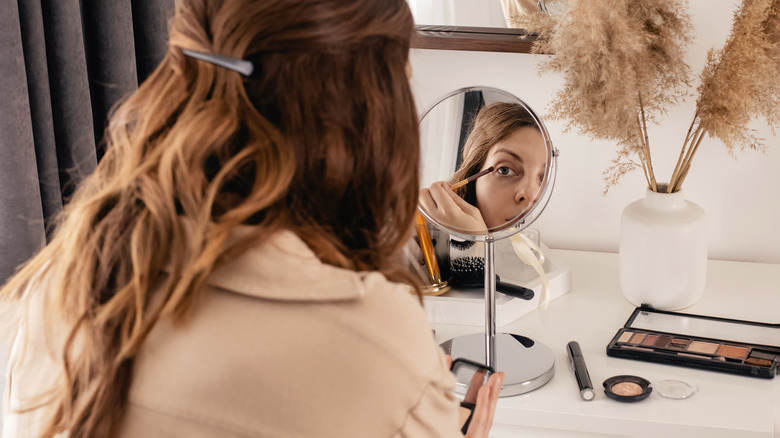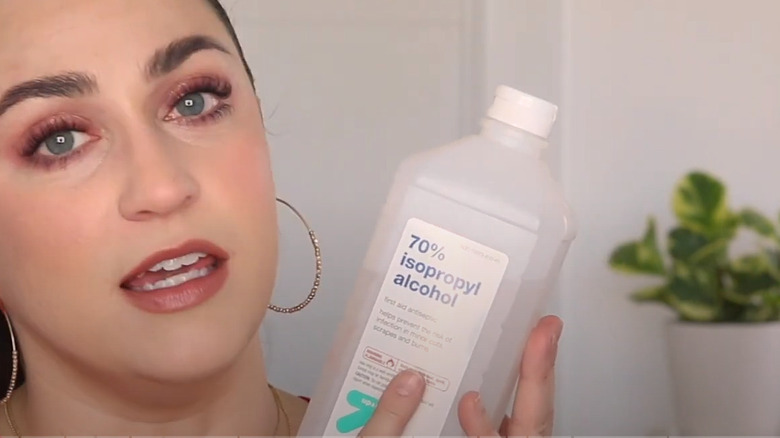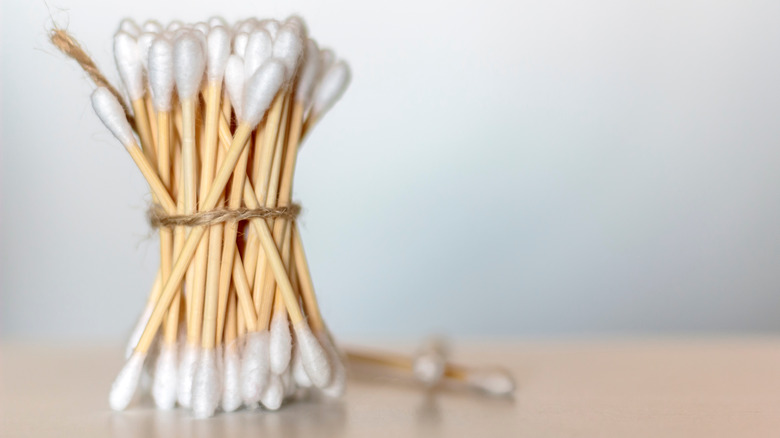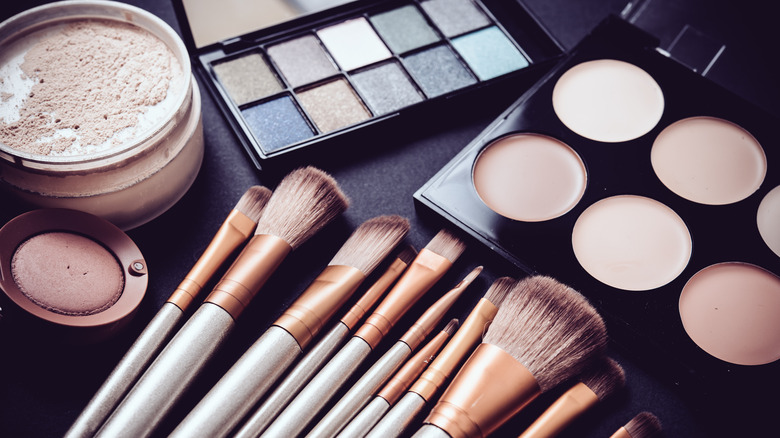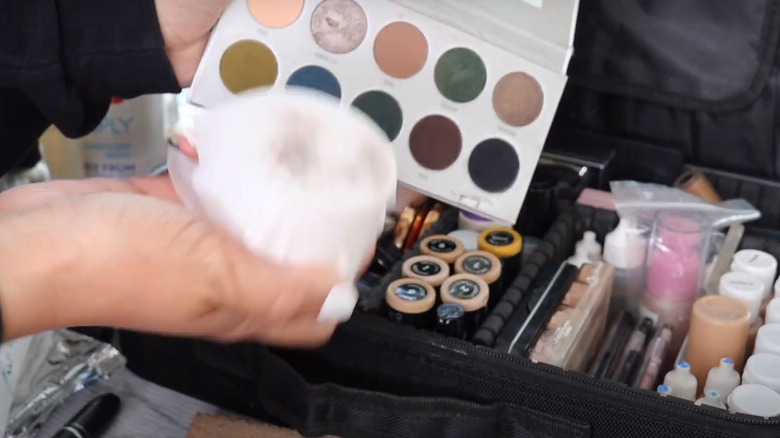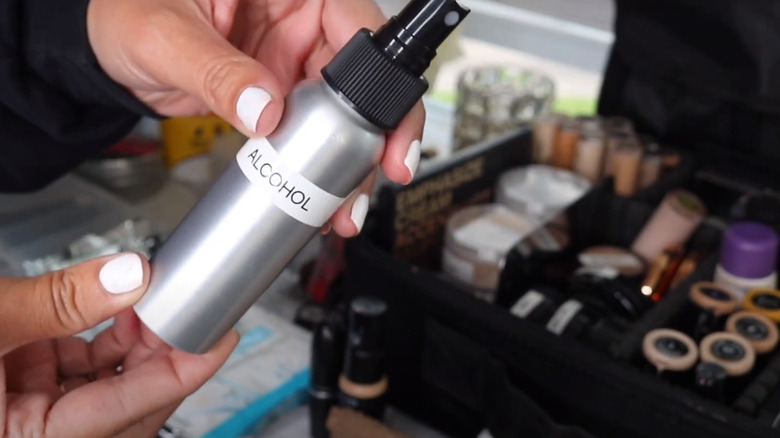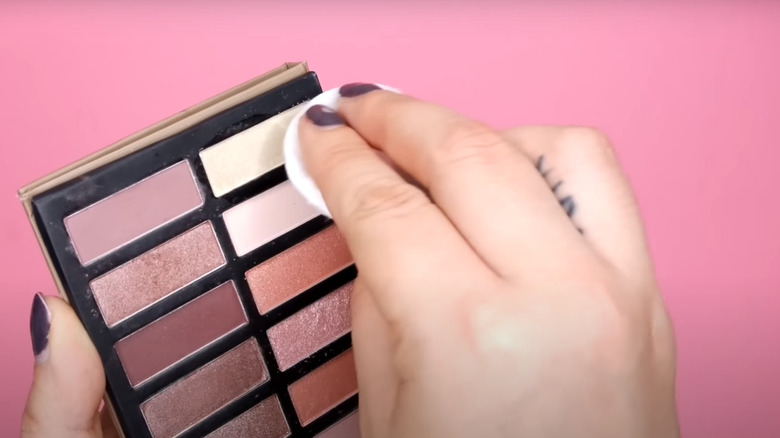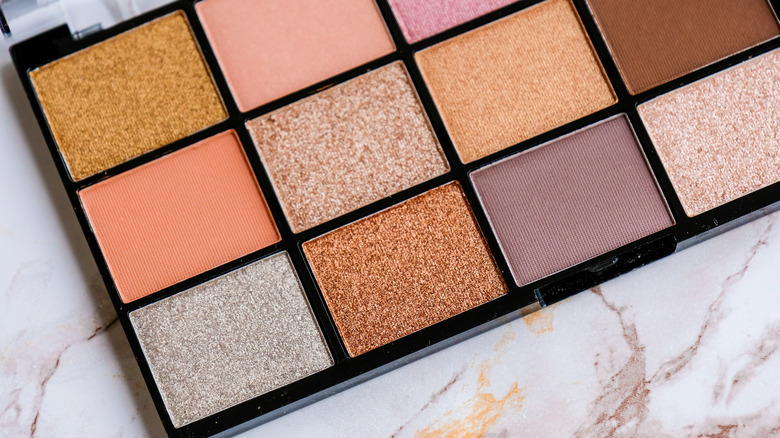How To Clean And Sanitize Your Makeup Palettes To Prevent The Spread Of Bacteria
In your daily skincare regimen, you might conscientiously cleanse your face both morning and night, employing a diverse range of products to eliminate dirt and residue to leave the skin refreshed and revitalized. Of course, you always carefully wash your hands before touching your face to prevent any bacteria from spreading. Moreover, you probably know how to clean your most-used beauty tools to keep them germ-free and regularly sanitize your brushes and sponges to ensure a pristine canvas for your beauty routine.
However, one often overlooked aspect of most people's makeup collection, when it comes to cleaning, is the palette. While it's easy to assume that the colorful array of eyeshadows, blushers, and cream foundations is immune to bacterial contamination, the truth is that these palettes can harbor unseen threats. Bacteria can easily accumulate on the surface of our makeup palettes — just like they do with our brushes — potentially leading to skin irritations and breakouts.
Bacteria can be deceptively present, and it's crucial to acknowledge their existence even in seemingly innocuous places. Like our brushes, makeup palettes demand our attention to remain hygienic. Not only does sanitizing prevent the spread of bacteria, but it also ensures that the vibrant colors are restored to their original shine, removing residue from other shades that frequently get transferred from our brushes. But first, what causes bacteria to spread on our makeup palettes?
What causes bacteria to spread on your makeup palette?
According to a 2019 microbiological study published in the Journal of Applied Microbiology, our makeup products are often contaminated with bacteria. About 79% to 90% of used products tested were found positive for bacteria such as Staphylococcus aureus, Escherichia coli, and Citrobacter freundii. The study concludes that "significant levels of microbial contamination occur during use of cosmetic products and presence of pathogenic organisms pose a potential risk to health," highlighting the urgency of proper makeup sanitation. Dermatologist Melissa Babcock, M.D., tells Piedmont that "bacterial contamination can lead to eye and skin infections such as cellulitis (generalized infection in the tissue) and abscesses (walled off pockets of pus and infection)."
But what causes bacteria to spread on our cosmetic products and, more specifically, on our makeup palettes? If we begin our makeup routine without thoroughly cleaning our hands, we will inadvertently transfer bacteria from our hands to our precious products. Similarly, if we dip our fingers into our makeup palette to use them as an impromptu eyeshadow brush, we are infesting our eyeshadows with germs residing on our fingertips. Therefore, Mi Skin Dermatology Center recommends always properly washing and sanitizing our hands before handling our makeup. Palettes not tightly closed and makeup kept in humid environments (such as in our bathrooms) are also susceptible to bacteria growth.
Before you clean and sanitize your makeup palette
When it comes to sanitizing, using a specially formulated cosmetic sanitizer works best since alcohol may dry up your palettes over time. However, in the absence of this special formulation, you may use alcohol as long as you take special note of the kind of alcohol you use. Freelance makeup artist Ivy Boyd explains in a YouTube video that to disinfect your makeup palette and tools properly, the alcohol should be 70% isopropyl. Many assume that the higher the alcohol content the better and mistakenly opt for a 90% solution. However, anything higher than 70% will evaporate too quickly and not leave adequate time for thorough disinfection.
According to WebMD, an alcohol solution with a 70% concentration works better than one with a higher concentration because it has a higher water content, which will allow it to more effectively target all sorts of bacteria. So, to ensure that your makeup palettes, be they cream foundations or powder eyeshadows, are completely bacteria-free, you should use a 70% alcohol solution. Having said that, take note that Boyd does state that it's best to use a special cosmetic sanitizer to protect your palettes from drying out.
Products you'll need to clean and sanitize your makeup palette
Next up, gather all your materials. Luckily, these are materials that most of us already have handy around our homes, even if you don't clean your beauty tools as often as you should, so there's no need to rush to the store to buy them. More specifically, you'll need cotton swabs, cotton pads, tissues, and a clean towel. Be sure to have these items within arm's reach to complete the sanitizing process quickly.
Since you will be using an alcohol solution, you'll need to have a spraying bottle to pour the solution in. As you'll be spritzing the alcohol onto your palette, a nozzle with an expansive reach is a must, and you may already have one for your morning hairstyling (or training your cats). Note that you'll also be using the alcohol to clean the surface you'll be working on, but you could use a disinfectant wipe for this.
Prep the working surface and gather your materials
Once you have all your materials ready, clean the surface that you will work on. Remove all unnecessary objects from the surface to create an unobstructed working area. Ideally, you need to have enough space to line up all your makeup palettes rather than stacking them one on top of the other. Spray a little bit of your alcohol on the surface and wipe it with a clean kitchen towel or paper towel to sanitize it.
Wipe the palette
The next step of your sanitizing project is to clean the plastic part of your palette and the casing that holds your eyeshadows or cream foundations. This is important as your brush will inadvertently touch the plastic case around your shadows, meaning that bacteria will be transferred to your skin during your makeup routine. Spritz some tissue paper with some alcohol (or the special cosmetics sanitizer), ensuring that it is sufficiently damp but not soaked; you don't want alcohol dripping onto your makeup. Gently wipe the case of your makeup palette, including the exterior cover and the base.
Alternatively, you may also use 70% alcohol wipes instead of spritzing alcohol on tissue. Wipes are easier to use, but there's no need to buy them if you don't have any handy. A tissue infused with alcohol will work just as well. To get into pesky corners, you may use a Q-tip cotton swab. Dip it in the alcohol for a few seconds and gently rub it on surfaces where dirty parts persist. This step will not only sanitize your palette but will also remove any dirt, residue, creams, or powder lying around, restoring your makeup kit to its former glory.
Spritz the palette with alcohol or special cosmetic sanitizer
You've got your palette casing all clean and sanitized, so it's time to turn your attention to your actual makeup. You will need to be a little bit more careful during this step, as you don't want to drench your palette and ruin your eyeshadows, cream foundations, and blushers. However, since this is where most bacteria will be breeding, you also need to be a little bit more thorough as well.
Hold your spraying bottle a few inches away from your palette and spritz a couple of times throughout the whole palette. No need to overdo it; anywhere between two and four spritzes should be enough. Leave the palette to dry for a few minutes before proceeding to the next part of your sanitation process.
Gently dab with a cotton bud infused with alcohol
Spritzing your palette with alcohol will, of course, sanitize it, but to be absolutely certain that you do not leave any part of your makeup unsanitized, one final step is warranted. Spritz a cotton pad with your alcohol solution. Gently dab each individual eyeshadow, blusher, and cream foundation with the cotton.
By doing so, you not only extend the sanitizing effect to every nook and cranny of your palette but also address specific areas that might be easily overlooked during a more generalized spritzing. This last step leaves no room for potential bacteria to lurk in the fine details of your makeup collection, ensuring that your skin remains bacteria-free and that spots and rushes are kept at bay.
Leave the palette in a clean spot to dry
Now it's time to let your cleaned palette air-dry. Place a clean towel on your work surface and leave the palette there until all alcohol solution has vaporized and your palette is completely dry and clean. Using a towel helps ensure that your palette stays on a clean surface during this step, preventing any potential cross-contamination from other surfaces. Let your palette dry thoroughly on the towel, and once it's ready, you'll have a sanitized and ready-to-use makeup kit that's no longer a breeding ground for bacteria.
